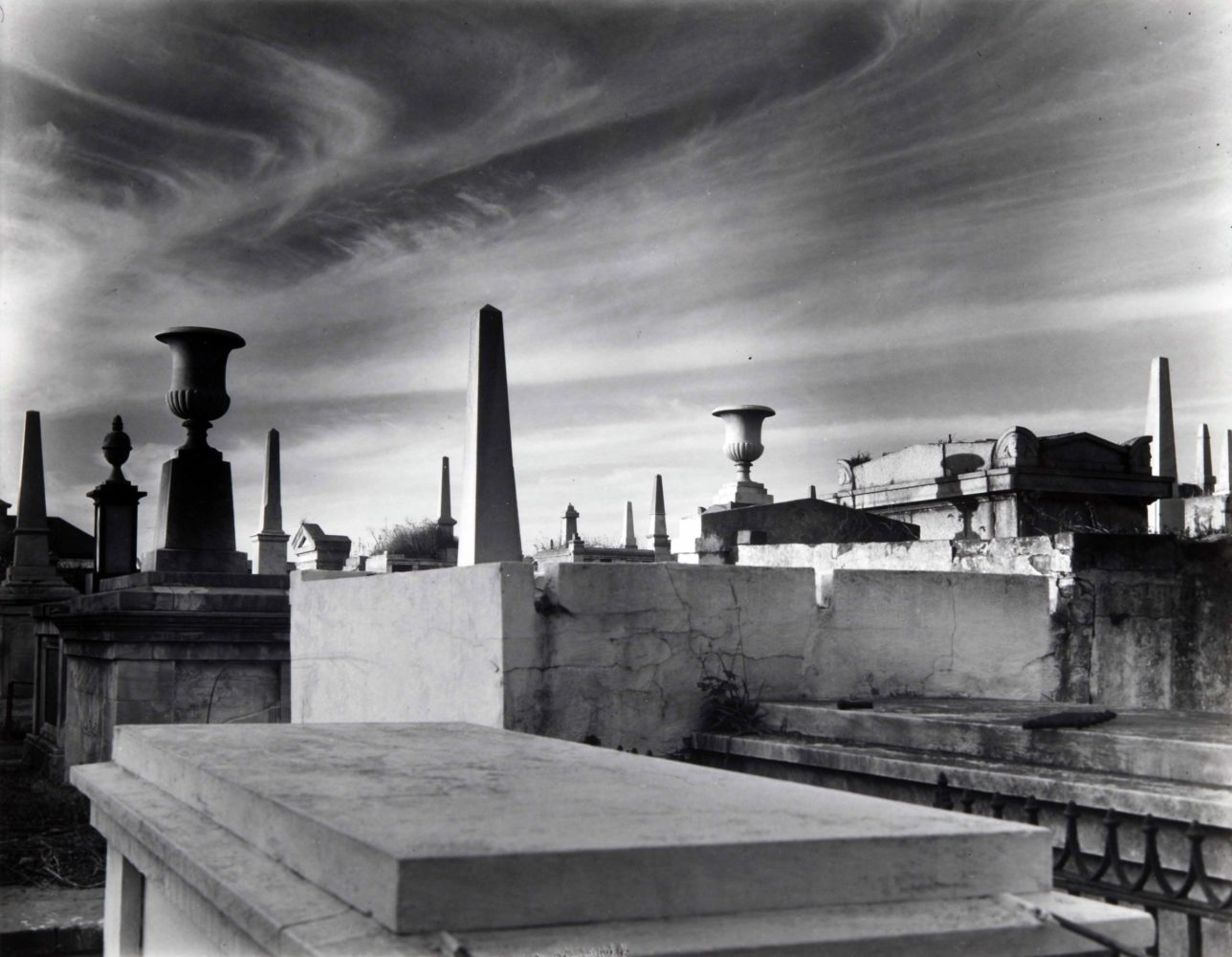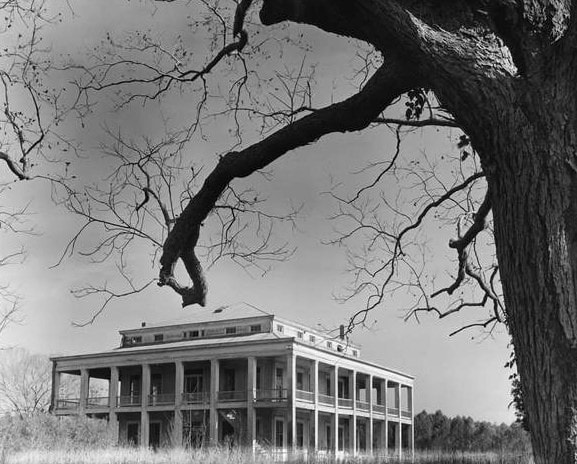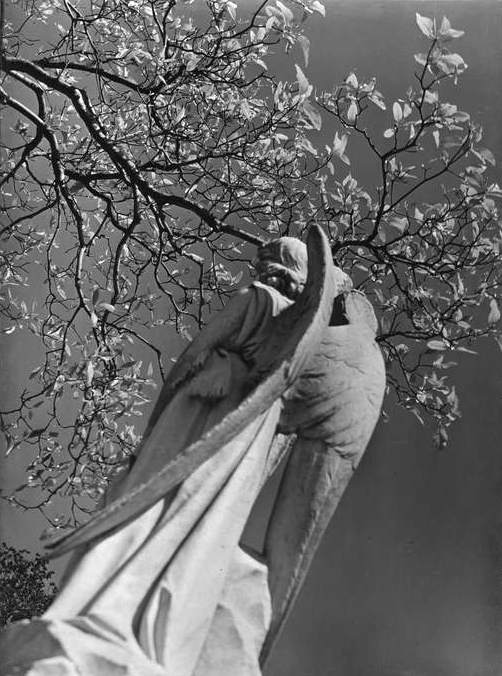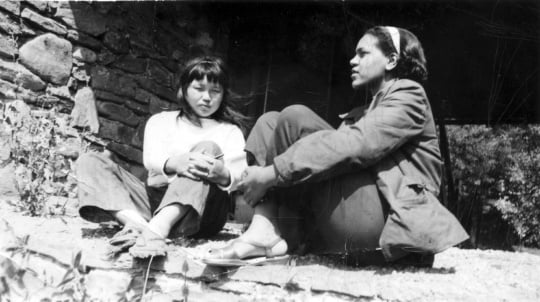
An upcoming exhibition at the High Museum of Art will feature the photography of Clarence John Laughlin (1905—1985), an artist known for his double-exposure images of romantic and desolate corners of the American South. The aptly titled Strange Light will showcase eighty photographs by the Louisiana photographer taken between 1935 and 1965.
In his photographs from the series Ghosts Along the Mississippi, Laughlin pictures decaying plantations that dot the Louisiana landscape. In Laughlin’s images, the bright-white homes of former plantation families glisten in the light. In the photograph Moss Fingers, Laughlin positions his viewer at the foot of Greenwood Plantation so that we might imagine ourselves looking up at the neo-Classical columns rising from the ground. The text that Laughlin wrote to accompany Moss Fingers describes the photograph as such: “A great dead tree rises; from it weird gray shapes seem to throng towards the lonely and supernatural beauty of the pillars, given life by light. And the great hand of the tree, clothed in moss—the robe of things dead—reaches its gaunt dripping fingers, in the failing light, towards the living and lustrous thing which is Greenwood.” In Clarence John Laughlin’s formulation, whiteness is evidence of beauty, stability, and order. Darkness is a sign of chaos, mystery, and death, personified here by the black moss dripping across the plantation home.
The symbolic meanings of white are quite entrenched. Despite some variations, the symbolic connotations for black and white in the Western imagination are largely understood in moral opposition to one other, white = good, black = bad. Christianity, which haunts the United State in general and the American South in particular, upholds these values in religious text. Think of God bellowing, “Let there be light,” and John the Baptist, who was described as “a burning and shining light.” God calls us “to be a light to lighten the gentiles.” Light, which is visualized as white, is truth and knowledge of God’s love.

This ‘white spirit’ is ever-present in Clarence John Laughlin’s pictures. We see this symbolic play again in the photograph titled The Minatory Arm, a picture of Bellechasse Plantation. The text accompanying the photo reads:
“Falling into ruin, it has, at least, been saved from the river, by being moved back on two occasions. . . . Looking at the house from the rear, we see how the leafless tree stretches its aged and threatening arm—the very arm of disaster—towards the structure. Let us hope that Bellechasse, too, will not fall victim to the years.”
This photograph is somewhat unusual because it offers a view of Bellechase Plantation from a distance. The white house still occupies the center of the photograph, asserting its primacy of importance. But what is interesting about this photograph in relation to the others in the collection is that Laughlin positions his viewer below a massive live oak tree behind the Big House, in the area of the plantation commonly referred to as the Yard. Historian John Michael Vlach identifies the Yard, an area of a plantation set behind the Big House, as the domain of the enslaved. Communal labor for large tasks took place in the Yard, and it was the area in which young children played while their parents labored. In Laughlin’s photograph, we can sense a physical and psychic separation between where the viewer is positioned under this sprawling tree and the home that sits sturdily in the distance.

Richard Dyer, a scholar in the field of whiteness studies, writes, “The sense of separation from the environment, of the world as the object of a disembodied human gaze and control, runs deep in white culture.” This separation from the environment is evident throughout Laughlin’s Ghostsseries in both form and text. The homes that Laughlin photographs sit squarely in the center of the frame. When he takes a broader view, as inThe Minatory Arm, and natural elements enter the photograph, they are used to illustrate death and decay. It is the uncivilized element that brings the homes, symbols of industry and civilization, into sharper view.
But there is another way to conceptualize the dark, one that runs in direct opposition to Laughlin’s formulation.
In his current exhibition at the Art Institute of Chicago, Night Coming Tenderly, Black, photographer Dawoud Bey departs from the intimate portraits of Black people for which he is known, images that speak in the language of figurative representation. The pictures in Night Coming Tenderly, by contrast, are almost entirely black, created through a photographic process of underexposure, and difficult to visually discern. In these photographs, Bey presents an American landscape concealed in darkness. They are unpeopled landscape photographs taken across Cleveland, Ohio, and their subjects—a house with a picket fence, a quiet creek, a dense thicket—might seem unremarkable until you read the wall text, which explains that the sites lie along the path of the Underground Railroad.
Bey is interested in visualizing this mythic space, an “enveloping darkness that was a passage to liberation.” As witnessing objects, the photographs allow the viewer to see the land through the eyes of a fugitive fleeing enslavement— that is, in darkness. However, there is also a second form of witnessing— one that is experienced by those of us whose genealogy aligns us not with the fugitive, but with the slave-catcher. In a way, Bey is still making portraits, only now they are portraits of people we cannot see. People who, for their protection, are hidden.

The photographs are large-format gelatin silver prints with highly reflective surfaces, which are exaggerated further when displayed under glass. In order to make out the details of the pictures, you have to move around them, give them space, and allow the light reflecting off their surfaces to reveal their visual contents before they are immediately concealed again. Depending on where you stand, you may be drawn into the blackness or pushed away from it. In this way, Night situates Bey in a lineage of artists, including Atlanta’s Paul Stephen Benjamin, among many others who, rather than portray the Black body, use blackness as a mode of abstraction. The photo critic Teju Cole writes, “What is dark is neither blank nor empty. It is in fact full of wise light, which, with patient seeing, can open out into glories.” Dawoud Bey’s photos reward such patient seeing, and time spent with them reveals not only the fine details hiding in the dark, but the capaciousness of the dark itself.
Bey selected a number of photographs from the Art Institute’s permanent collection to be hung at the exhibition’s entry, serving as a sort of prelude to his images. Among them are pictures by canonical photographers whom Bey admires—Gordon Parks, Alfred Stieglitz, William Eggleston, among others—but also vernacular snapshots of everyday, unknown Black people. One particularly generous connection Bey makes is with the African American photographer Roy DeCarava. DeCarava described his photographs as being “about the concept of a world shaped by blackness.” Indeed, not only are DeCarava’s images mostly of Black people, but they revel in the dark. DeCarava disregarded the Zone System, the technique invented by Ansel Adams which dictated that photographs should include all tonalities from the darkest black to the whitest white, and instead made images that move ever so subtly between shades of gray.


In an essay about DeCarava, Teju Cole deftly articulates the protestations and possibilities that lie in the dark: “The viewer’s eye might at first protest, seeking more conventional contrasts, wanting more obvious lighting. But, gradually, there comes an acceptance of the photograph and its subtle implications: that there’s more there than we might think at first glance, but also that, when we are looking at others, we might come to the understanding that they don’t have to give themselves up to us. They are allowed to stay in the shadows if they wish.”
This technique of fugitivity, this staying in the shadows, is at work in text paintings by artist Glenn Ligon. In his Strangers series, Ligon appropriates the text from James Baldwin’s 1955 essay “Stranger in the Village,” in which Baldwin recounts the sense of otherness he felt while living in Switzerland. As the only Black man in his small village, Baldwin experienced an acute sense of being on display. In his essay, he recounts the painful moments of recognition when children on the street scream at him, “Neger! Neger!” In Ligon’s hands, the violent words become illegible underneath layers of black oil stick and coal dust. By concealing Baldwin’s experience in the dark, Ligon forecloses on future possibilities of hateful recognition and violence.
In his essay “For Opacity,” the Martinique philosopher and poet Édouard Glissant makes a case against transparency, against the Western notion that understanding each other is the key to accepting one another. Rather than make himself apparent and risk reduction, Glissant would rather exist more opaquely. “As far as my identity is concerned,” he writes blithely, “I will take care of it myself.” Glissant may have been speaking of a metaphorical opacity, but in the photographs of Dawoud Bey, opacity— evidenced in his case by blackness—is mobilized to both envision and protect his unseen human referents. In Untitled (Bent Branches), Bey dissolves the figure/ground relationship so that his viewer in enveloped in dense, chaotic wilderness. In this work, the traditional symbolic formulation of white and black is upturned and the dark, unbridled nature is not a symbol of death, but a source of fugitivity, liberation, and life.
Disclaimer: Burnaway executive director Erin Jane Nelson worked on the High Museum’s forthcoming Clarence John Laughlin exhibition prior to joining the organization.




